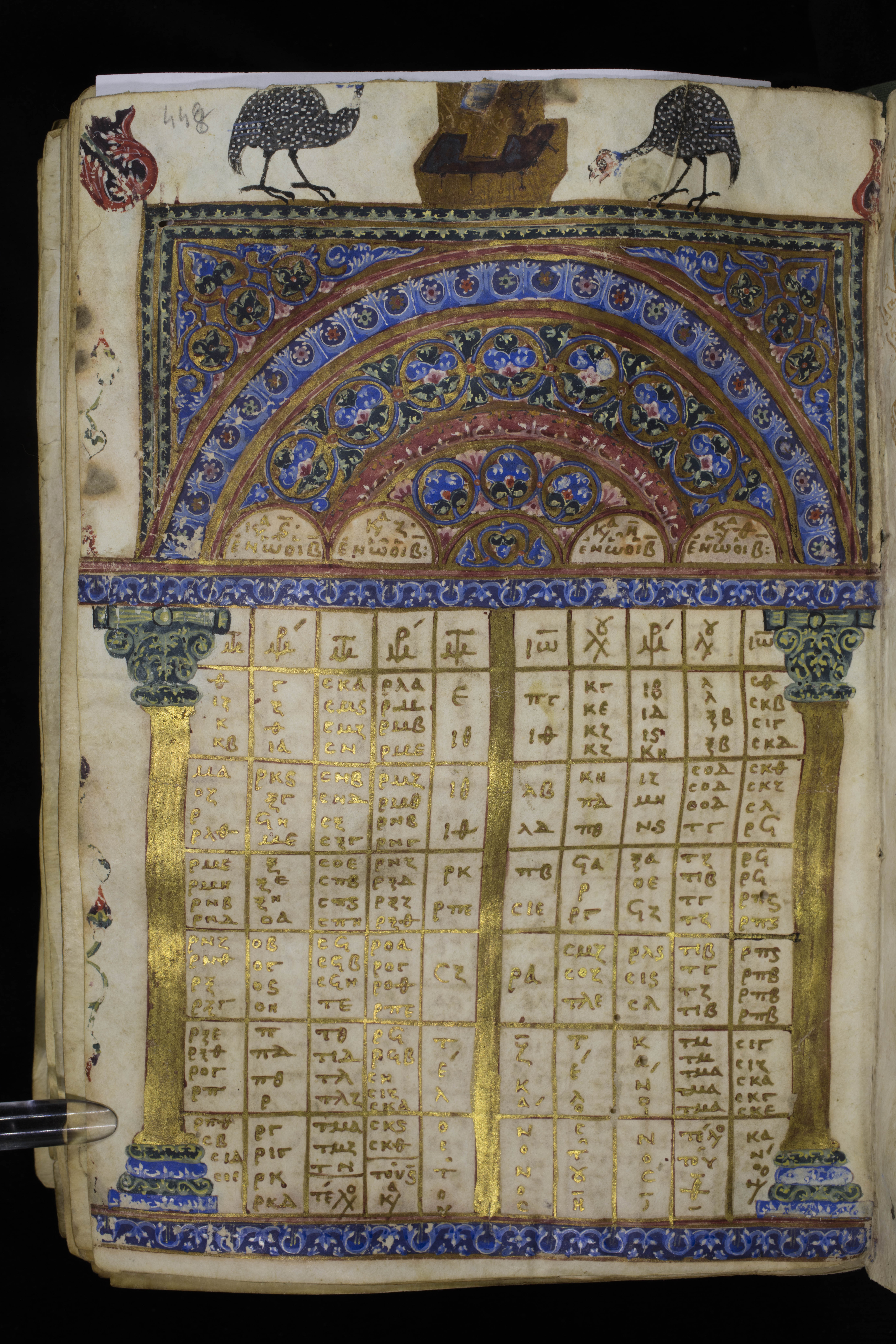By: Andrew J. Patton and Leigh Ann Thompson
When readers open up the beginning of a Gospel manuscript, whether physically or digitally, they often come across pages of lists that are arranged in columns and made up of Greek letters. These lists are often some of the most decorated pages of Greek Gospels manuscripts.
Besides displaying the talented artistry of manuscript decorators, these lists are a unique and interesting feature of Greek New Testament manuscripts. They come from a series of ten tables, called canons, that were introduced into the Gospel codices by Eusebius of Caesarea. We find in a letter he wrote to Carpianus that he took information from one Ammonius the Alexandrian to construct a system of tables that indicate where similar material appears in the Gospel books. Bruce Metzger defines the Eusebian Canon as “a device for showing which passages in each Gospel are similar to passages in other Gospels.” This navigational tool appeared in many manuscripts and reflects the ongoing systems of concordance and marginal notation that students of the Bible employ today.
Tables
Eusebius benefited future generations by writing a letter to Carpianus because in this letter he described the tables and the system he used to create them. His ten canon tables each designate passages that occur within a certain grouping of Gospel books. The passages were counted by paragraph, therefore the numbers in each table correspond to which paragraph holds the particular passage as counted from the beginning of the book. Canon table I contains all passages that occur in all four gospel books. The image below is a picture of Canon I.
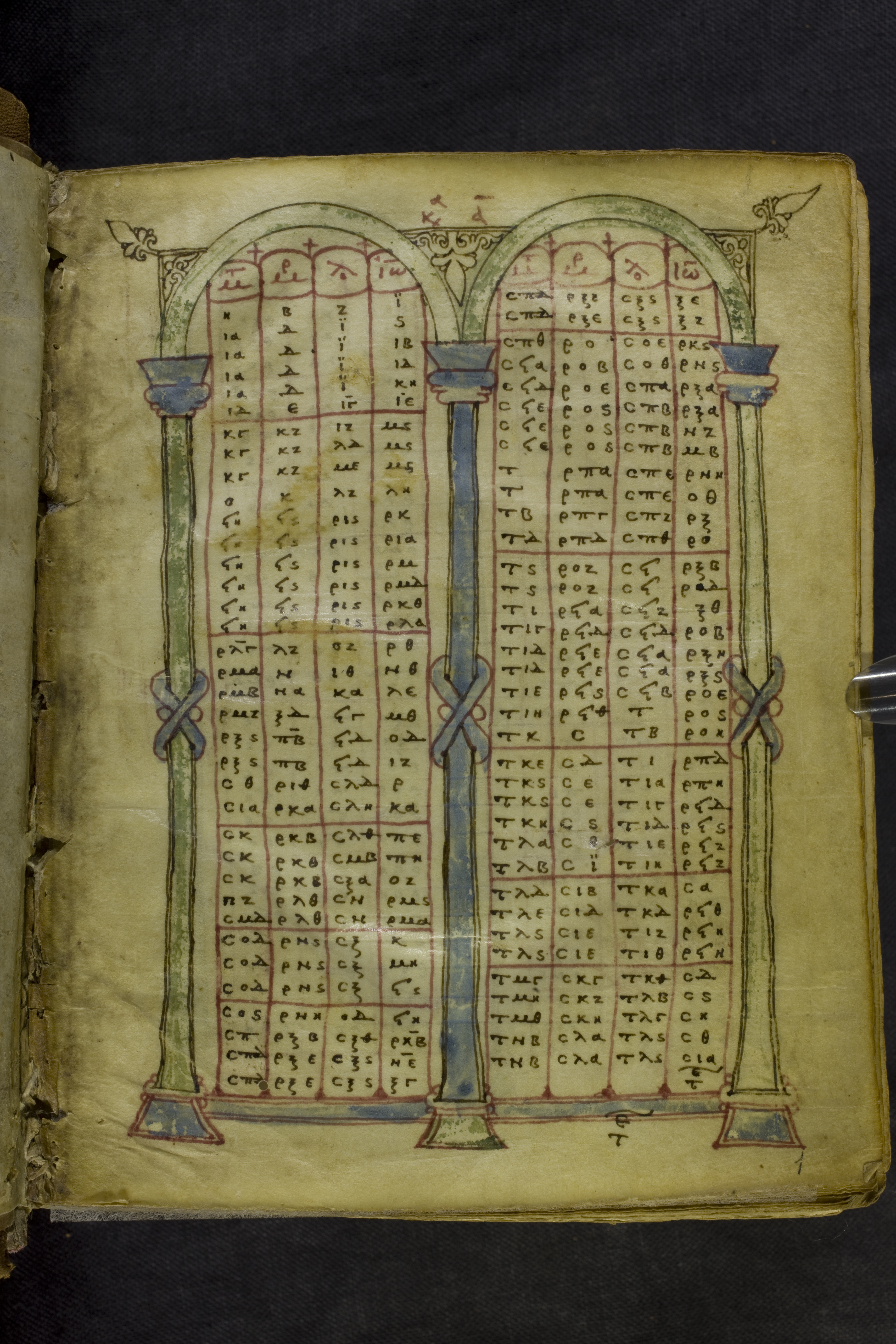
Tables II to IV indicate which passages appear in three of the four books. Interestingly, each of these tables includes the passages included in Matthew and the other Gospels (e.g., Matthew-Mark-Luke; Matthew-Mark-John; Matthew-Luke-John); there is not a table for passages only found in Mark-Luke-John because there are no parallel passages found only in Mark, Luke, and John.
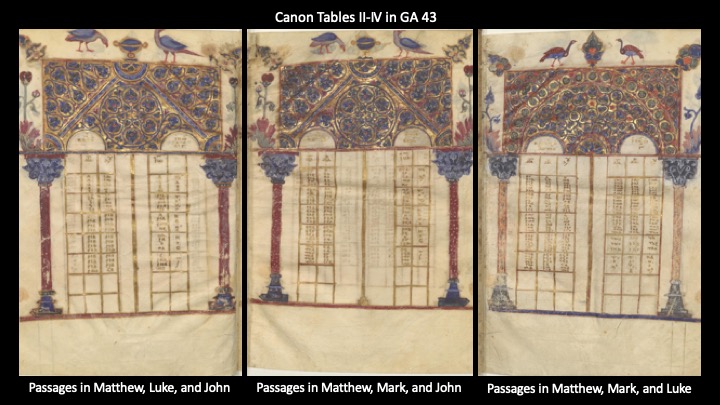
Each book is paired with one other in tables V to IX to show which passages occur in just two of the Gospel books.
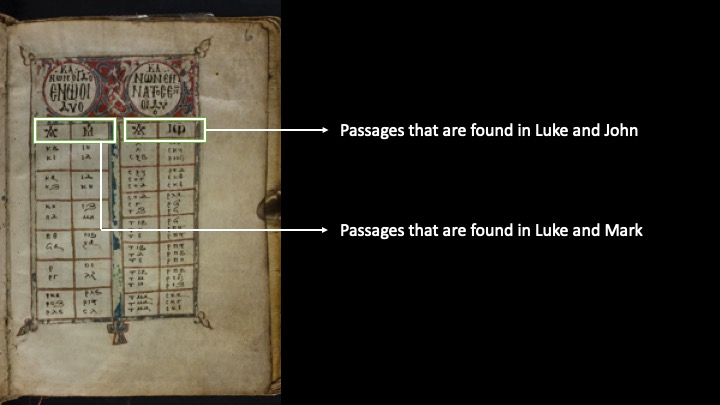
The final table, Canon X, shares which passages are unique to each of the Gospel books. See GA 106 at the Chester Beatty Library in Dublin, GA 9 from the Bibliothèque nationale in France, and GA 86 at the Academy of Sciences in Slovakia for examples of all ten tables.
Marginalia
The symbols in the canon tables are repeated in the margins at the beginning of the passage. These marginal notations are called capitula parallela. Notice the Greek numbers in margins in the following examples.
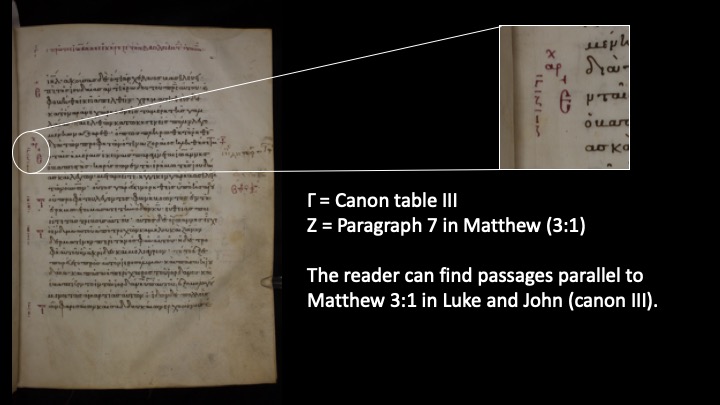
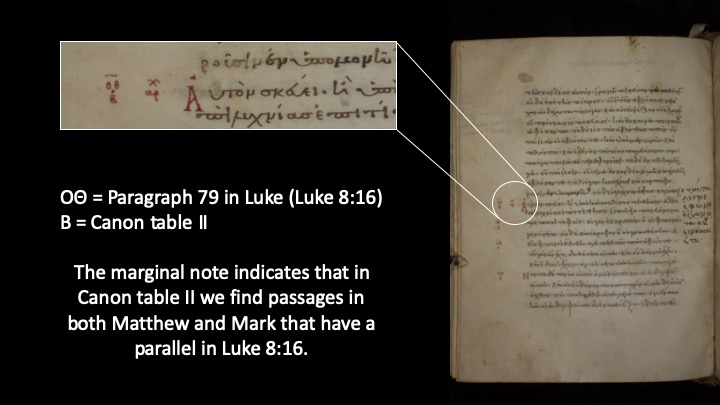
The canon table indicated by the marginal notation demonstrates which other Gospel books contain a similar passage. Even more, by turning to the referenced canon table, readers can find those passages in the row with the one they were reading.
Contemporary Examples
The Eusebian Canons were an ingenious way to navigate through the four Gospels, and their continued use in New Testament manuscripts indicates that they were helpful for Bible readers. Since Eusebius, we have developed new navigational tools for Bible reading—the most notable of these is chapter and verse numbers, first introduced to the New Testament in Stephanus’ 1551 edition of the Greek New Testament.
Nestle-Aland Greek New Testament
The standard critical edition of the Greek New Testament for biblical research and text criticism is the Nestle-Aland Novum Testamentum. This hand-edition still incorporates elements of the Eusebian Canon. Just before the printing of the Gospels, they include the Greek text of Eusebius’ letter that explains the canons, followed by the canon tables. Then in the inner margins, the editors place the capitula parallela corresponding to the tables. Having the Eusebian Canons in the Greek New Testament is an aid to text critics studying manuscripts and maintains continuity with the history of textual transmission.
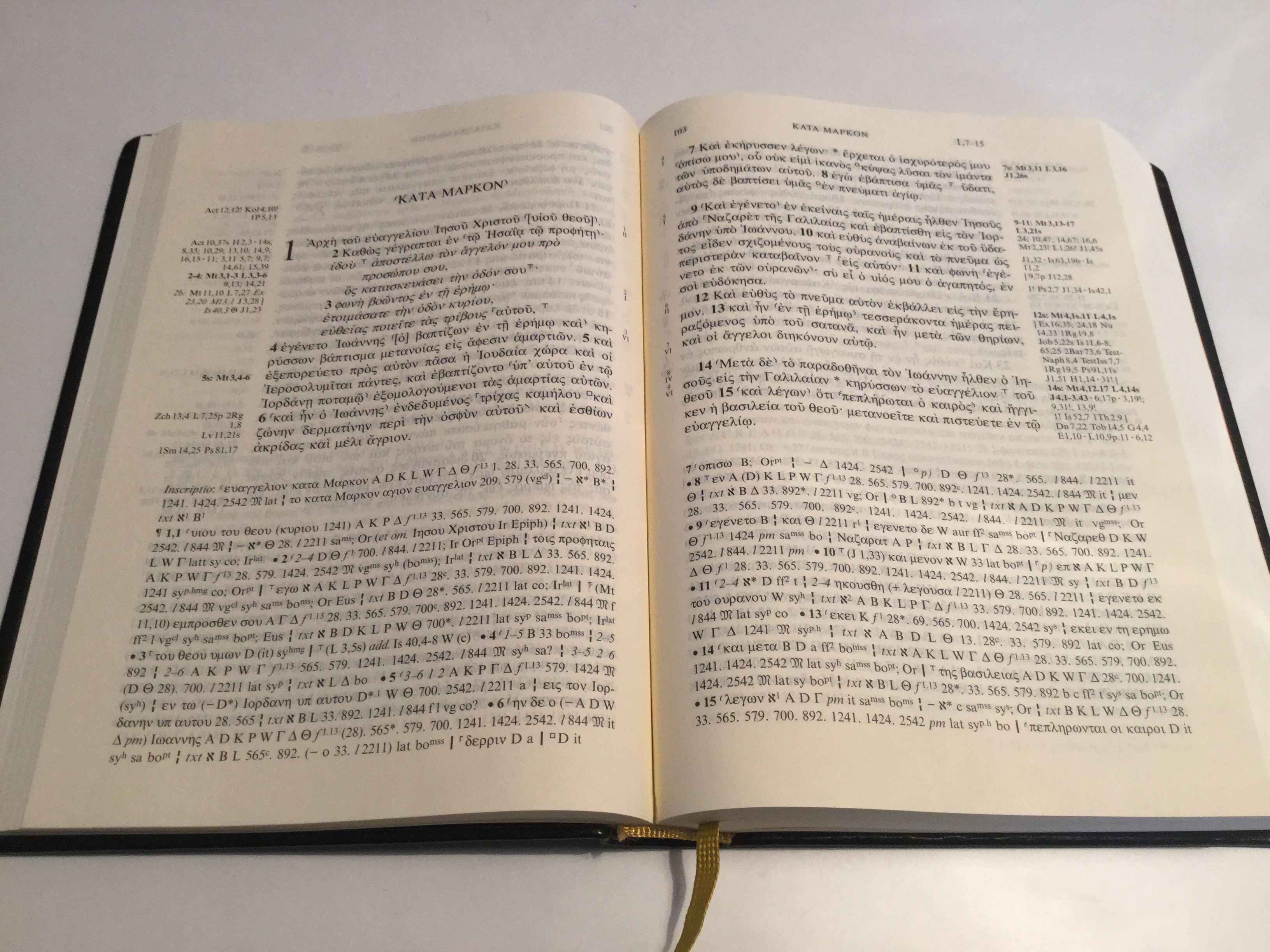
Synopsis of the Four Gospels by Kurt Aland
Another approach to identifying and examining the parallel passages in the Gospels is Kurt Aland’s Synopsis of the Four Gospels. This work prints the text of the Gospels in four columns, presenting parallel passages adjacent to one another. Aland’s format makes quick comparisons of the text immediately possible.
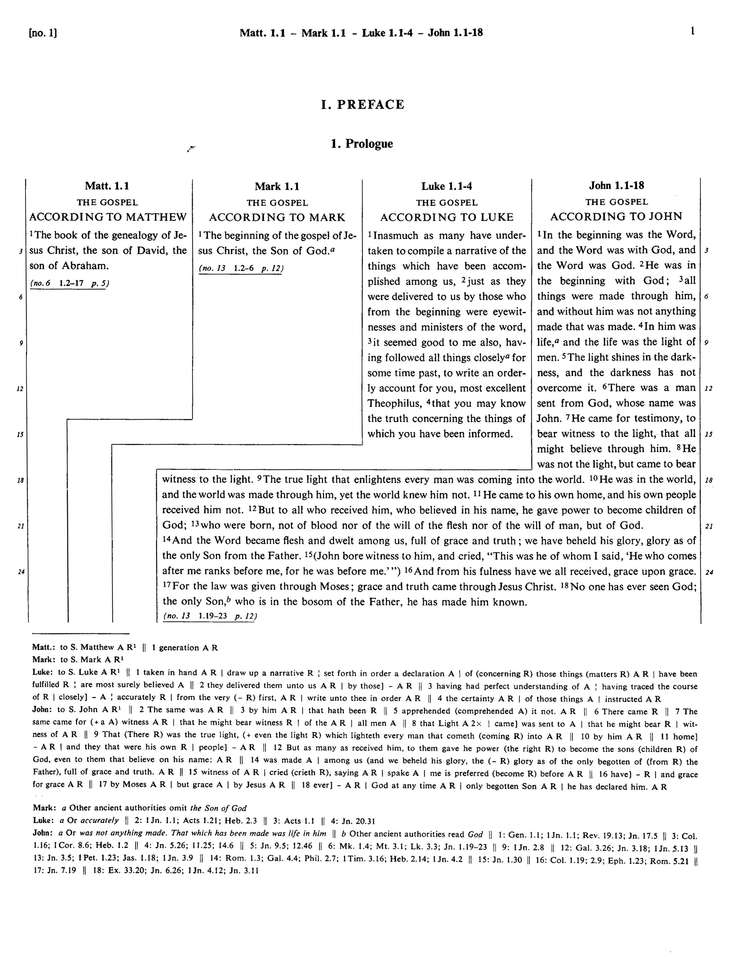
Modern Bibles
While modern Bible translations do not reprint the Eusebian Canons, many still try to inform the reader about parallel passages in the Gospels. The most common method are reference notes located on the page that give the chapter and verse number for the parallels. This system also allows translators to expand the scope of the references to include allusions, citations, and similar texts.
What is clear from contemporary editions of the Greek New Testament and modern translations is that scholars, students, and Bible readers share the same desire of the ancient readers. We all want tools in our Bibles that help us navigate between the various books and enable our reading to be informed by the whole canon.
The Eusebian Canons in Modern Scholarships
Eusebian Canons, including the capitula parallela, are one of the most frequently included paratextual features in Greek New Testament manuscripts. They were an essential tool for navigating the Gospels, and, in illuminated manuscripts, they enhanced the beauty of the codex.
It is clear that Eusebius’ system was useful for navigating between the Gospels. But how are Eusebian canon tables and capitula parallela useful for reconstructing the initial text of the New Testament? Satoshi Toda helpfully observes the significance of Eusebian canons as an early witness to the macro-level content of the Gospels. Eusebius, he explains, died circa 340 CE, and his work was completed prior to this date. Therefore, the Eusebian canons predate most of our Greek New Testament manuscripts, especially those that still contain significant portions of the text of the Gospels. Thus, Toda would argue that the presence of a text on a canon table should be a valuable external witness to its authenticity. An example of the textual function of this paratext is the lack of an original Eusebian canon for the long ending of Mark (any material after Mark 16.8) or for the Pericope Adulterae (John 7.53–8.11).This is another indicator against the originality of these two highly disputed passages. In this way, he shows that paratextual details like the Eusebian Canons are valuable for the work of text criticism, not only for navigating the Gospels.
If you are interested in seeing additional examples of Eusebian canon tables, you can easily search for them in CSNTM’s manuscript library. Under the heading “MS Feature,” click the check box for “Canon Table,” and any manuscript with a page tagged will populate. Once you click on the manuscript you’re interested in viewing, only those pages with the feature will be displayed in the thumbnail viewer.
Sources and Further Reading:
Metzger, Bruce M. Manuscripts of the Greek Bible: An Introduction to Greek Palaeography. New York: Oxford University Press, 1981.
Metzger, Bruce M. and Bart D. Ehrman. The Text of the New Testament: Its Transmission, Corruption, and Restoration. 4th ed. New York: Oxford University Press, 2005.
Parker, David C. An Introduction to the New Testament Manuscripts and Their Texts. New York: Cambridge University Press, 2008.
Toda, Satoshi. “The Eusebian Canons: Their Implications and Potential.” Pages 27–44 in Early Readers, Scholars and Editors of the New Testament: Papers from the Eighth Birmingham Colloquium on the Textual Criticism of the New Testament. Edited by H. A. G. Houghton. Texts and Studies Third Series 11. Piscataway, NJ: Gorgias, 2014.

